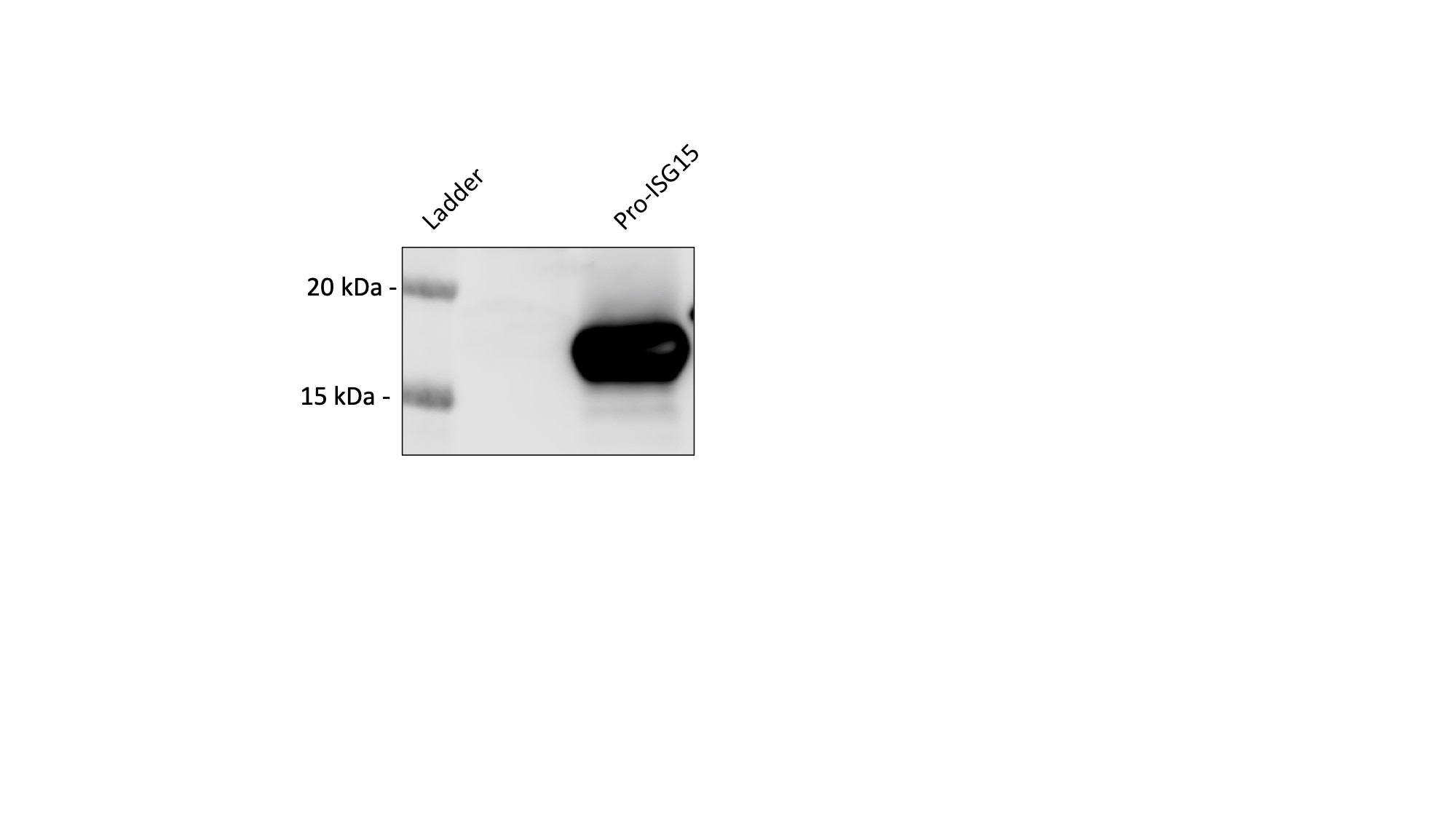Recombinant Human Pro-ISG15 Protein, CF
Recombinant Human Pro-ISG15 Protein, CF Summary
Product Specifications
Product Datasheets
Carrier Free
CF stands for Carrier Free (CF). We typically add Bovine Serum Albumin (BSA) as a carrier protein to our recombinant proteins. Adding a carrier protein enhances protein stability, increases shelf-life, and allows the recombinant protein to be stored at a more dilute concentration. The carrier free version does not contain BSA.
In general, we advise purchasing the recombinant protein with BSA for use in cell or tissue culture, or as an ELISA standard. In contrast, the carrier free protein is recommended for applications, in which the presence of BSA could interfere.
UL-615
| Formulation | X mg/ml (X μM) in 50 mM HEPES pH 7.5, 300 mM NaCl, 10% (v/v) Glycerol, 1 mM DTT |
| Shipping | The product is shipped with dry ice or equivalent. Upon receipt, store it immediately at the temperature recommended below. |
| Stability & Storage: | Use a manual defrost freezer and avoid repeated freeze-thaw cycles.
|
Reconstitution Calculator
Background: ISG15/UCRP
Interferon-stimulated Gene 15 (ISG15), also known as Ubiquitin Cross-reacting Protein (UCRP), is a Ubiquitin-like protein that is covalently coupled to target proteins in a process termed ISGylation. It is a 165 amino acid (aa) polypeptide with a predicted molecular weight of 18 kDa. ISG15/UCRP exhibits 66% aa sequence identity with its mouse ortholog. Structurally, ISG15/UCRP consists of two tandem Ubiquitin-like domains that share a similar 3-dimensional structure with Ubiquitin and other Ubiquitin-like modifiers including NEDD8 and SUMO1. Modification of targets by ISG15/UCRP occurs in a stepwise enzymatic process similar to that of Ubiquitin. Enzymes regulating ISGylation include the activating (E1) enzyme UBE1L, the conjugating (E2) enzyme UbcH8, and ligases (E3) such as EFP/TRIM25 and HERC5 (1-4). Removal of ISG15/UCRP is catalyzed by the deconjugating enzyme UBP43/USP18 (5). Functionally, ISG15/UCRP has putative roles in the immune response and tumorigenesis. This is reflected by intracellular ISG15/UCRP targets that include Cyclin D1, tumor suppressor p63, IRF3, and a range of viral proteins (6-8). It is induced by type 1 interferons and microbial infection, and knockout mice exhibit an increased sensitivity to infection by some viruses (6). ISG15/UCRP can also be secreted by cells of the immune system and may act in a cytokine-like manner (9). For instance, it is produced by human granulocytes in response to mycobacterium exposure, and natural killer cells and T cells respond to extracellular ISG15/UCRP with IFN-gamma production (10). Further supporting a role in immune function, ISG15/UCRP mutations are associated with MSMD, an inherited disorder characterized by increased susceptibility to mycobacterial infection (10
Pro-ISG15 (165 amino acids) is the inactive precursor of ISG15 (163 amino acids).The precursor is processed at the C-terminus by an ISG15-specific protease UBP43 (also knownas USP18). The mature form of ISG15 contains the conserved C-terminal di-glycine residues which are critical in activation and conjugation reactions. This protein can be used as a negative control in ISGylation reactions or as a substrate for UBP43.
- Yuan, W. & R.M. Krug (2001) EMBO J. 20:362.
- Zhao, C. et al. (2004) Proc. Natl. Acad. Sci. USA 101:7578.
- Zou, W. & D.E. Zhang (2006) J. Biol. Chem. 281:3989.
- Wong, J.J. et al. (2006) Proc. Natl. Acad. Sci. USA 103:10735.
- Malakhov, M.P. et al. (2002) J. Biol. Chem. 277:9976.
- Zhang, D. & D.-E. Zhang (2011) J. Interferon Cytokine Res. 31:119.
- Jeon, Y.J. et al. (2012) J. Clin. Invest. 122:2622.
- Harty, R.N. et al. (2009) J. Innate. Immun. 1:397.
- Owashi, M. et al. (2003) Biochem. Biophys. Res. Commun. 309:533.
- Bogunovic, D. et al. (2012) Science 337:1684.
Citations for Recombinant Human Pro-ISG15 Protein, CF
R&D Systems personnel manually curate a database that contains references using R&D Systems products. The data collected includes not only links to publications in PubMed, but also provides information about sample types, species, and experimental conditions.
2
Citations: Showing 1 - 2
Filter your results:
Filter by:
-
The vOTU domain of highly-pathogenic porcine reproductive and respiratory syndrome virus displays a differential substrate preference.
Authors: Deaton M, Spear A, Faaberg K, Pegan S
Virology, 2014-03-15;454(0):247-53.
-
Human rhinovirus-induced ISG15 selectively modulates epithelial antiviral immunity.
Authors: Zaheer R, Wiehler S, Hudy M, Traves S, Pelikan J, Leigh R, Proud D
Mucosal Immunol, 2014-01-22;7(5):1127-38.
Species: Human
Sample Types: Whole Cells
Applications: Bioassay
FAQs
No product specific FAQs exist for this product, however you may
View all Proteins and Enzyme FAQsReviews for Recombinant Human Pro-ISG15 Protein, CF
Average Rating: 5 (Based on 1 Review)
Have you used Recombinant Human Pro-ISG15 Protein, CF?
Submit a review and receive an Amazon gift card.
$25/€18/£15/$25CAN/¥75 Yuan/¥2500 Yen for a review with an image
$10/€7/£6/$10 CAD/¥70 Yuan/¥1110 Yen for a review without an image
Filter by:


